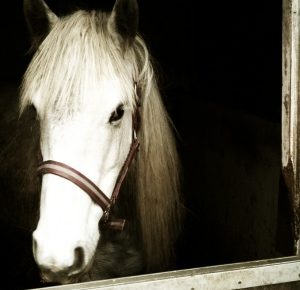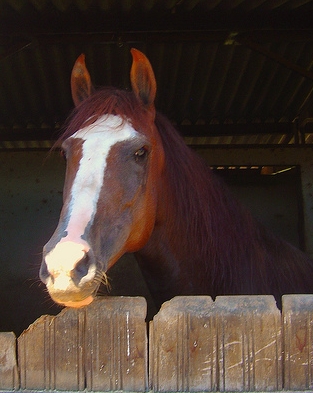This article will give you an overview of what to expect those first few, critical days.
As horse lovers our hearts break when we see horses in need. This article will help clarify what role you can take and how best to care for your new rescue if you go that route. I have taken in rescues, ‘unofficially’ for 17 yrs. and will share with you how I get them settled in and on the way to a better life! I’ll share before and after pictures of my most recent ‘kill pen’ rescues saved from slaughter and a local rescue, starved and neglected as she was left in a field. Knol
Rescue Horse, Day One
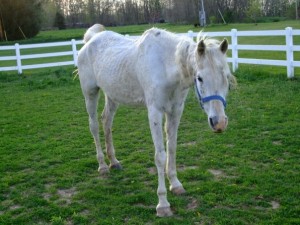
What a Difference A Year Makes!
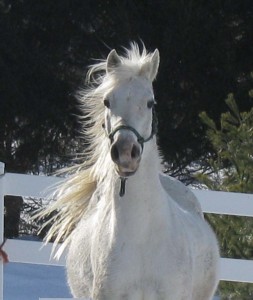
Boomer recovered in my care once individual feeding and proper barn management practises were applied, along with regular worming, farrier trims and vaccinations. She had been kept in a herd situation prior to being in my care. She was not able to compete for food, shelter or water. The less food she got the weaker she became and so started a quick decline in her condition. The first photo was taken in early April 2009. The second photo was taken in March 2010.
As the horse market continues to get beat and pommelled more and more horses are finding their way to the most unfortunate of places. A glut of horses from the racing industry, overbreeding or owner’s facing tough financial times with a shortage of buyers has created a terrible situation for our beloved horses. Add to that the horse auctions are there to offer a quick way to unload a horse. The horses are often picked up by a horse brokers who then travel to various auctions with horses often being bought by ‘kill buyers’. The kill buyers ship their weekly or bi-weekly trailer rig loads of horses to slaughter houses in Mexico and Canada. Why a horse gets picked up by a kill buyer often has no bearing on what kind of horse it is. I used to think young or trained, healthy horses rarely ended up going to slaughter. I was wrong.
A worst case scenarios if you are a horse would be:
1. left to slowly starve either in a field or filthy barn somewhere, riddled with parasites and rain rot
2. Herded and shuffled around in crowded, stressful conditions from one horse auction to another until finally after a long, agonizing trailer ride you get to Canada or Mexico and are slaughtered for meat.
3. Or both.
One of the things that were readily apparent in my recent rescue horses eyes was the sheer terror of their experience. I have taken in rescues for years. In the past I most often got my rescues by coming upon them in my horse circles or horse shopping and buying them outright from the owners. They suffered, no doubt – often in a long drawn out slow decline by being neglect and starved in a stall or stuck out in someone’s backyard mud pen. Or they possibly fell into bad times due to mishandling by inexperienced owners. But I must say the horses who have been on what must be trailer rides from hell arrived at my place shell shocked.
Rhythm, Day One
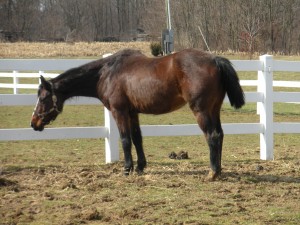
One Month Later
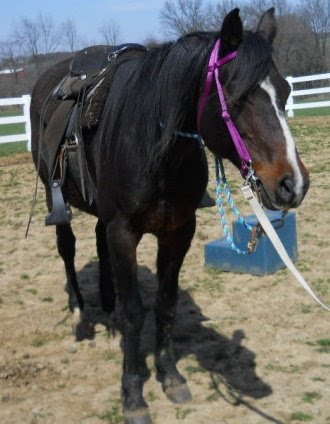
The change in her demeanor is obviously brighter. In the first photo she still has her heavy winter coat so its not as apparent how thin she was. More noticeably too was how little muscle she had. Simple turn out and food have filled her out very nicely. We had a few ‘training’ issues to work out but I now enjoy riding her bareback with a rope halter. Her age has been estimated to be anywhere from 14-20-ish. She has a naturally calm disposition. I see her as becoming a good beginner’s horse or as a quiet trail horse before long.
Darcy, Day One Shell Shocked
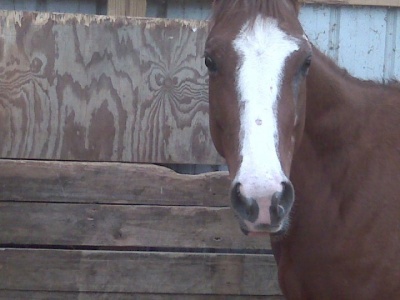
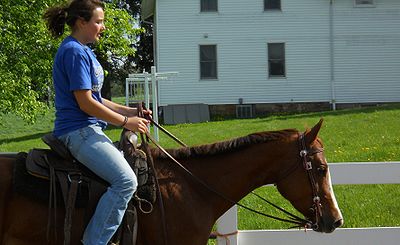
Darcy is a 5 yr old registered quarter horse. Dary’s original owner/breeder had her clipped, groomed and conditioned for her first sale at a large All Breed Sale barn in mid March. From there Darcy traveled from Wisconsin to Minnesota to Pennsylvania to West Virginia and then home to Ohio in the month before she came to me. From what I can gather she was picked up at the first sale by a horse broker. From there Darcy was on a fast sprial downward simply by being at the wrong place at the wrong time. Although physically she was healthier and stronger then Rhythm, she was exceedingly stressed out when she arrived. She was banged up, cut, scraped, man handled with a bad case of rain rot/fungus. Her disposition is naturally sweet and trusting, thankfully, but she was SO out of her element in those kinds of conditions. Who wouldn’t be?? What a way to ‘come of age’ to the ways of the world!
I have had Rhythm since early March and Darcy from mid April of 2010. They were rescued from the ‘kill pen’ at an auction with the help of Another Chance 4 Horses. I will share my experiences and advice.
It is recommended that the horses be quarantined for a minimum of 2 weeks but preferably 30 days. The horses get exposed to who knows what at these auctions and you don’t want to expose your other horses if you can at all help it. I started off with trying to keep mine separated but because of how my barn and pastures are laid out it didn’t last. I don’t recommend this. With a little research you can find ‘quarantine’ barns who will take your horse in during this initial period.
Right off the bat the horse will need a vet to look them over. They should be wormed and vaccinated. Let your vet guide you on the timing. I often worm my rescues twice a few days apart once I know they are eating, drinking and making manure. What you don’t want to do is give a wormy, weak, stressed horse a strong wormer which could potentially kill a large number of worms at once and bring on colic. You also do not want to overload a weak, stressed, thin horse’s digestive system with alot of grain. As tempting as it is to load them up on the food and nutrition they desperately need you must ease into it. Go slow. Boomer, the white horse pictured at the top of this article was started off on a handful of grain and plenty of grass hay.
When my horses first arrive my main priority is getting water into them. I feed them soaked beet pulp and have lots of clean, fresh water for them. I feed a second cutting grass hay. Soaking the hay in water before feeding is an option too. I want them to ‘de-stress’, eat, drink and poop. I keep things quiet and low keyed. No introductions to lots of new people, horses or anything like that. As exciting as it is to bring them home they are just not themselves at this point. They need to veg out in a quiet stall or small paddock where they can see other horses but don’t have to interact or establish a herd position. A weak, sick horse knows how vulnerable they are and they are scared. I do not try to make demands as far as handling them, grooming or any unnecessary touching unless they have an urgent medical condition that needs to be dealt with. They are on super alert and reactive from all they’ve been thru– or on the verge of shut down. Either way give them the quiet they desperately need. They have just come from closed in, cramped spaces with strange horses, rough handling, loud noises and unfamilar sights and are on super overload.
At this stage it is very important to keep a close eye on what they eat and drink. I will introduce grain very slowly in the next day or so but make sure they are eating hay first. I let them get a belly full of hay and water to get their digestion working and moving. Make dietary changes slowly. Ease them onto pasture slowly and only after you get hay and water into them. Fresh grass can bring on colic or loose manure even in small amounts in the beginning and the last thing they need is to get dehydrated. You hopefully will see them over the next 3 days or so begin to show some interest in their surroundings and you as the ‘food bearer’. When that happens it is my indication I can begin to interact and touch. Slow is the key. I remember in particular the guarded, distant look in Rhythm’s eye that spoke volumes as to what she’d been through. Darcy was sweet and more sociable but slightly lethargic and depressed for the first week and a half to 2 weeks.
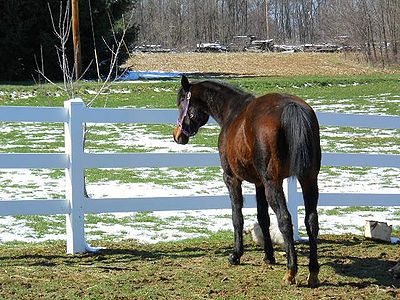
Usually rescues come to you with little or no history. I assume the worst and hope for the best. I assume my new rescue kicks, bites etc. until they show me otherwise. I assume they have bad riding habits. I assume they don’t tie well. Sometimes bad behavior is what got the horse in a bad situation in the first place or the horse started out ‘good’ but the bad situation brought on bad behaviors. Who knows how they were handled in all the shuffling. If they were abandoned or neglected they could be pushy and ill mannered on the ground. Be cautious and careful. Again go slow.
To show a brighter side as well you could be pleasantly surprised at how sweet, kind and manageable your new rescue horse is. Some horse owners who aren’t aware of just how many horses go to slaughter send well trained horses through auctions. My horses pictured above have proved themselves to be easy to handle. I don’t want to paint too bleak of a picture because the tragedy is many very nice horses go thru these kind of sale barns week after week. You just have to be aware when first handling them that you do not know what behaviors they may have.
Cautions:
Personally I would not take in an unbroke horse unless I had lots of money for a trainer or was a trainer myself. I can say this now very definitively because one of my first rescues was an unbroke, pregnant, lame, ‘skin and bones’, skittish, arabian broodmare. I am glad I rescued her because I have her 16 yr. old daughter but one could spend a lot of money very quickly this way . They also are the ones that tug on your heart so strongly. Please, please don’t breed your mare unless you are willing to take responsibility for the offspring.
Do not look for a horse for your kids at an auction unless you are a professional horse person. The best thing you can do for your horse crazy kid is give them lessons (lots and lots of lessons) with a safety minded instructor and then encourage them to volunteer at a rescue or therapy barn for at least a year doing barn chores. Do the nitty gritty, back breaking barn work. Then get a horse for your kid with the help of their riding instructor so the child can be matched with a horse with the level of training your child needs. Kids need to know you can not ride a horse like you do a bicycle- take it out, ride, put it away until the next ride. They also need to have the horse handling experience and balanced seat that only comes from lots of time on and with horses.
Be prepared for vet expenses. Horses are not cheap and are notoriously high mantenence. In addition to worming, shots and farrier, the horse likely needs its teeth floated relatively soon. Barring any unforeseen illnesses this alone will cost around 200.00 on up so depending on your vet and farrier. They will need these things done on a regular basis from here on out too. The inital cost of a rescue horse or one bought at an auction is practically irrelevant because the real cost is in keeping horses. There is no such thing as a cheap or free horse. If you have your own place there are ways to cut expenses. I’ll share tips in another article.
Keep in mind your area’s boarding expenses or your personal barn management issues. A new rescue needs a stall in the beginning so you can monitor their food and water intake and assess their mental state and training stage. Pasture board at this stage is not a good thing. It is safer to assess whether a horse will tie … in a stall rather than as it runs loose in a field somewhere. Or how it accepts a saddle or picks up its feet. Is it cinchy or sore? Is the horse aggressive or pushy? Easy to catch? What kind of ground manners does this horse have? Its tempting to want to save them all when the weather is beautiful and you can fill up your open field with rescue horses but these horses especially need to be handled and interacted with very regularly. You do the horse no favors if you get more than you can keep up with. I have to tell myself that daily because I have not met a horse I do not want. :) Ask my husband. If you are counting on help from other people in caring for your horse(s) I have learned in my 18+ years of keeping horses on my property that offers of help will flock to you in May/June but be few and far between in Jan. and Feb. when the work and commitment really kicks in. These horses got in the shape they did because someone somewhere got in over their head, either financially or physically. What feels good but busy on the farm in May feels like hell in Feb. during a week long ice storm. Only take in what you can realistically care for in the worst weather. I have a winter a few years ago etched in my mind when I had a boarding stable and cared for 27 + horses. We had a winter from hell when it rained, froze, rain, froze until everything flat surface had inches of slippery ice on it. The horses could not go out for fear of breaking a leg. Heck. I could hardly walk to the barn without fear of breaking a leg! This went on for what seemed like an eternity but probably was 2 or more weeks. I couldn’t get the tractor out to spread manure or haul hay from one barn to another. The feed delivery man could not get down our lane to bring feed or bedding. 20 some horses eat and poop alot! I had space for all the horses and we survived without any injury but it was stressful and unpleasant and completely out of my control. Had I not had the space and reserves of hay, feed, bedding it would of been disastrous. Horses can lose condition quickly.
With all this said, being able to rescue the animals you love is very rewarding. The happy Cinderella stories are the ones in which the horse goes from skin and bones to beautiful, healthy, gentle, ridable creatures. This is what we all hope for. Caution and restraint is needed so you can enter into rescuing a horse with your eyes wide open.
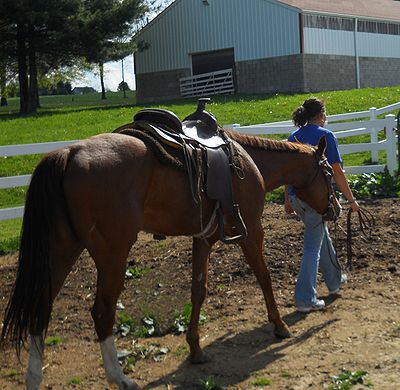
With all this said you can skip much of the risks mentioned above and adopt a horse from a reputable rescue and still very much be a hero. In fact when a horse is adopted directly from an equine rescue you save two lives- the horse you adopt and the new one you make room for at the rescue. Most rescues have already vetted and evaluated the horses ready to be adopted so the risk is much less. They know the horses behaviors and want to make a good match for you and the horse.
If you are newer to horses or are looking for a family horse consider an older horse from a rescue. Often these are the real treasures because they become wonderful teachers and are so deserving of good care and love.
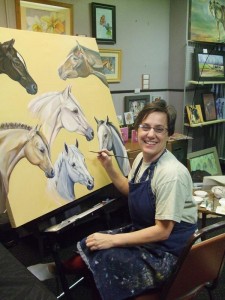
Sue Steiner, animal artistI am an equine artist with a passion for painting animals and rescuing horses (and dogs but thats another article). I practise restrainst daily by caring for the rescue horses I have and not taking in more until I have an opening. In the meantime I contribute by encouraging others and by giving a 25 % donation to an equine rescue for each pet portrait, horse portrait commission or art purchase that mentions this article. You can contact me thru my web site at http://www.suesteinerpetportraits.com . While there please read about my ‘Save a Face’ Project for those of us who want to save them all!
Related articles:

